The day you put a plant in the ground is the first day of a relationship. If you plant cosmos, that relationship constitutes one season. If you plant a tree, that relationship might survive for generations. If you plant shrubs, you could have a good many years of pleasure ahead of you-provided you prune. Woody shrubs, left to their own devices, go to rack and ruin. They spend no end of effort piling on enough wood to send the tips of their branches to the sky. What is the big attraction of the sky? No competition for light, air, and rain. No shrub feels any inclination to bloom where you want to see blooms-at eye level, that is. Plants grow with survival in mind. Should you have another idea in mind, wade in. Participate.
Shrubs will grow sideways, around an obstacle. They will sprout back, if cut to the ground. They will survive the indignity of a homeowner with a hedge trimmer gone amok. They will survive, even though the overall shape may be ungainly, or sheared to within an inch of its life. The instinct to live is strong. Lucky for me, and every other gardener who has learned on the job. Pruning a hydrangea is not hard-it just requires the patience to consider every branch, before you cut. I prune each branch, one at a time.
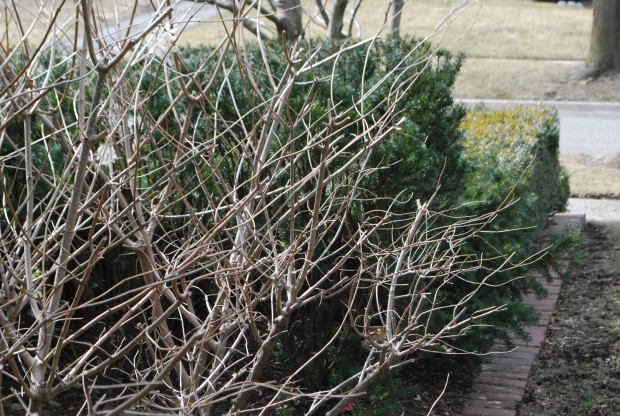
A well pruned hydrangea looks like it has had a shag haircut. Every branch has its our airspace. This means some branches get last year’s flowers cut off-only. Other branches get 8″ removed. Others get 16″ removed. Some old and thick branches in the middle get cut even harder, so air and light can reach down in to as many branches as possible. Some gardeners prune their Limelight hydrangeas to within 14″ to 24″ of the ground, forcing them to produce basal shoots which originate underground. This method tends to produce a shorter shrub, with fewer and larger flowers. I dislike cutting this hard-it takes so long for the shrub to regain a natural and airy shape. I would rather have lots of flowers, than a few gigantic flowers. I would rather plant the shorter growing version of Limelight- “Little Lime” – than prune a Limelight too hard.
I like my Limelight hydrangeas tall, and I like lots of flowers. My yews are 48″ tall at this end of the garden, and the arborvitae are 14′ tall. The hydrangeas grown 6′ to 8′ tall-perfect for this spot. For good flowering from top to bottom, the lower branches need to be left long, and the top branches need to be shorter. The finished shape should be very loosely pyramidal, or like an egg on its side. Step back frequently, to see how things are shaping up. This hydrangea blooms on new wood, so no matter how you prune, you will get flowers. Shearing a branch will encourage that branch to produce multiple shoots below the cut. Thicken up, and out. As long as the exterior shape is loosely described, the shrub will prosper. Shearing deciduous flowering shrubs may take less time, but produces less than desirable results. Renovating shrubs that have been sheared takes a long time. One cut at a time-this is my advice. Invest in a great pair of pruners-this makes the work easier. The moment that all I can hear is the birds, and the action of the pruner blades bypassing each other, is a spring gardening moment I treasure.
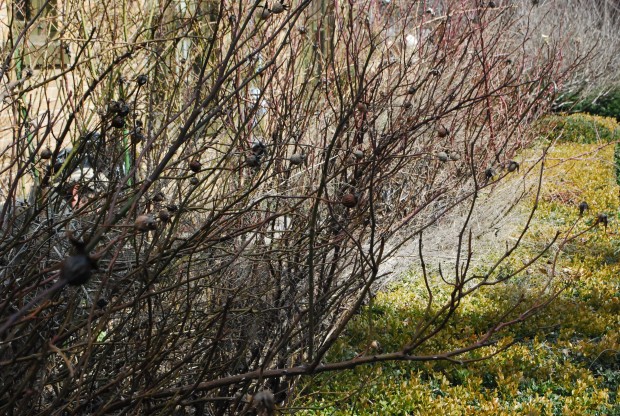 I do grow a few shrub roses. Sally Holmes, Carefree Beauty and Earthsong. I have read lots of articles about pruning roses, none of which I have paid much mind to. I stop dead heading my roses in mid-August. I actually love the rose hips in the fall and winter. In the spring, when the buds swell, I prune. The swelling of the buds? You will recognize swelling buds when you see them. My roses bloom on the new shoots. I never cut a branch back by more than 1/3rd. I prune the entire collection of roses as if they were a single plant. I leave them loose. Last fall I secured the summer’s growth of the climbing roses to the wall-not much needs to be done to them now.
I do grow a few shrub roses. Sally Holmes, Carefree Beauty and Earthsong. I have read lots of articles about pruning roses, none of which I have paid much mind to. I stop dead heading my roses in mid-August. I actually love the rose hips in the fall and winter. In the spring, when the buds swell, I prune. The swelling of the buds? You will recognize swelling buds when you see them. My roses bloom on the new shoots. I never cut a branch back by more than 1/3rd. I prune the entire collection of roses as if they were a single plant. I leave them loose. Last fall I secured the summer’s growth of the climbing roses to the wall-not much needs to be done to them now.
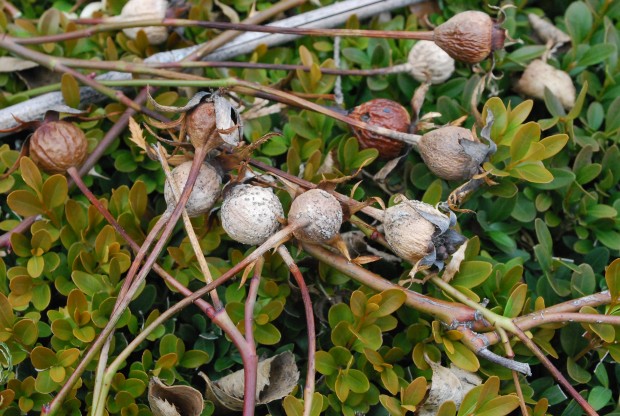 Occasionally I will hard prune an old climbing rose cane low to the ground. This keeps new growth coming from the bottom. Pruning stimulates growth. Pruning a climbing rose cane 6 feet off the ground will result in a rash of shoots. A long stalk with a tuft of shoots on the top-not the best look. Any cane which you can train to grow horizontally will flower more heavily. If you think about the where the sun and rain comes from, this makes sense. Is the afore mentioned a guide to pruning roses-not really. Every gardener has to deal with their roses one to one. Look at them, and decide how to prune. I prune my roses so they have the best possible overall shape. Most roses are very ungainly growers, so pruning for a good shape is not always so easy. That’s why I grow asparagus with my roses. The ferny fronds conceal those awkward and ungainly branches. Do I prune my asparagus over the summer-oh yes. I keep them at a height which conceals those legs. Does this affect my asparagus crop? Maybe. But everything in the garden is about choices. I want great roses more than I want home grown asparagus.
Occasionally I will hard prune an old climbing rose cane low to the ground. This keeps new growth coming from the bottom. Pruning stimulates growth. Pruning a climbing rose cane 6 feet off the ground will result in a rash of shoots. A long stalk with a tuft of shoots on the top-not the best look. Any cane which you can train to grow horizontally will flower more heavily. If you think about the where the sun and rain comes from, this makes sense. Is the afore mentioned a guide to pruning roses-not really. Every gardener has to deal with their roses one to one. Look at them, and decide how to prune. I prune my roses so they have the best possible overall shape. Most roses are very ungainly growers, so pruning for a good shape is not always so easy. That’s why I grow asparagus with my roses. The ferny fronds conceal those awkward and ungainly branches. Do I prune my asparagus over the summer-oh yes. I keep them at a height which conceals those legs. Does this affect my asparagus crop? Maybe. But everything in the garden is about choices. I want great roses more than I want home grown asparagus.
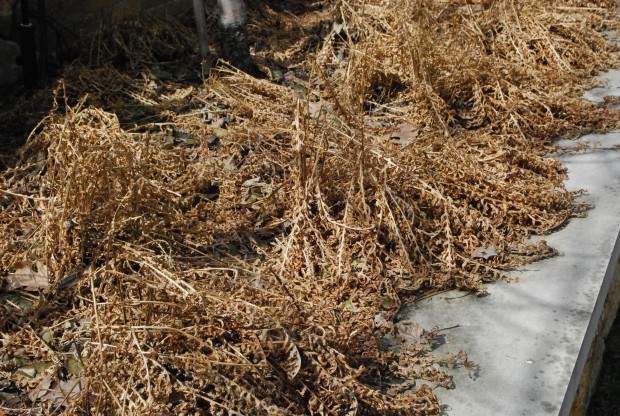 I do not cut back my beech ferns in the fall. The dead fronds mulch and protect the European ginger over the winter. By April 1st, those fronds have cut loose from the crown. I do not need to prune. I rake them off. A rubber rake does a great job. My fingers do the best job.
I do not cut back my beech ferns in the fall. The dead fronds mulch and protect the European ginger over the winter. By April 1st, those fronds have cut loose from the crown. I do not need to prune. I rake them off. A rubber rake does a great job. My fingers do the best job.
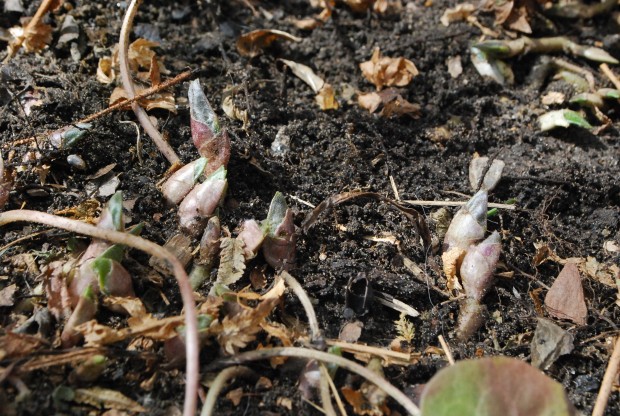 The European ginger has already been busy, sending out new shoots. A steel rake, or a size 8 boot can damage these tender new shoots. One of the pleasures of the spring-the new growth. Friable soil. My housekeeping inside-rather rude and abrupt. I just want to get the job done. When I am cleaning the garden in the spring, I take my time. I do it-gently. I have a relationship with this garden that I intend to nurture.
The European ginger has already been busy, sending out new shoots. A steel rake, or a size 8 boot can damage these tender new shoots. One of the pleasures of the spring-the new growth. Friable soil. My housekeeping inside-rather rude and abrupt. I just want to get the job done. When I am cleaning the garden in the spring, I take my time. I do it-gently. I have a relationship with this garden that I intend to nurture.
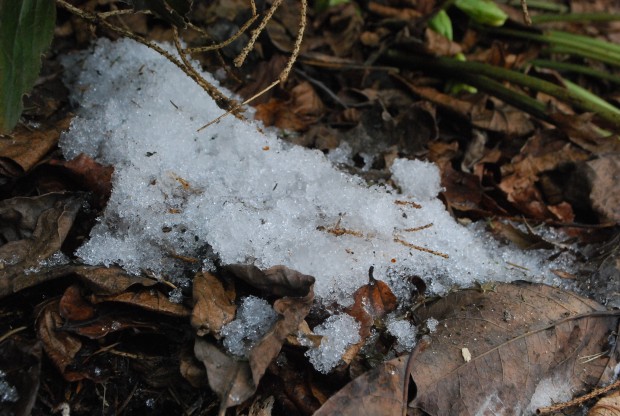
Lifting a lower branch of a spruce, I see icy snow. The transition from winter to spring has been incredibly slow this year. Really shady spots in my garden are still frozen. The night temperatures are still below freezing. Frozen ground, frozen branches-my advice is to let them be.
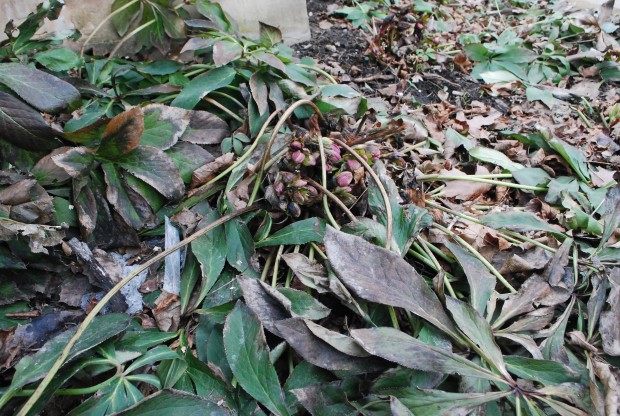 The hellebores are awake. Last years foliage has collapsed in a heap on the ground. Every day I think about cutting that old foliage away. Clean and bare is not always the best situation. The newly emerging flowers benefit from all that fluff. The transition from winter to spring can be a rocky journey. Sometimes, the best thing to do is to do nothing.
The hellebores are awake. Last years foliage has collapsed in a heap on the ground. Every day I think about cutting that old foliage away. Clean and bare is not always the best situation. The newly emerging flowers benefit from all that fluff. The transition from winter to spring can be a rocky journey. Sometimes, the best thing to do is to do nothing.
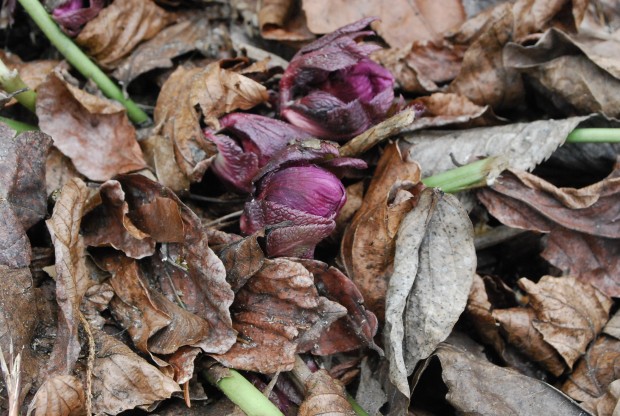 Last year’s foliage protects those flowering stalks, ready to emerge. A warm spell in March proved to be damaging. The buds sensed it was time to grow. Nature had a different idea in mind. We have had a run of really cold weather, the past 3 weeks. Some of the exposed buds on this plant are black with the rot produced by freezing temperatures.
Last year’s foliage protects those flowering stalks, ready to emerge. A warm spell in March proved to be damaging. The buds sensed it was time to grow. Nature had a different idea in mind. We have had a run of really cold weather, the past 3 weeks. Some of the exposed buds on this plant are black with the rot produced by freezing temperatures.
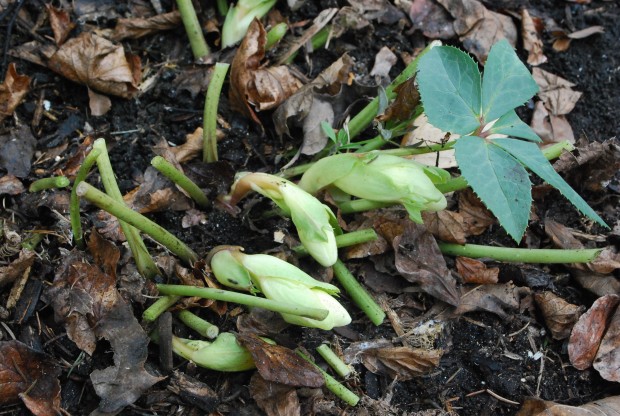 Cutting away last years foliage exposes new flower buds. Very tender flower buds. Just to look at them, you would know they are not armed against the cold. I cut the dead leaves away, and put them back over the top of these buds. It is too soon to clean here. What constitutes better days? Warmer nights. The ground is still very cold. It will be 2 months before the soil really warms up in my zone. Hellebores do not require warm soil, but the flowers will be damaged by night air temperatures in the mid to low 20’s. They need all that litter on the ground over them. It’s not time yet to wash and put away the blanket.
Cutting away last years foliage exposes new flower buds. Very tender flower buds. Just to look at them, you would know they are not armed against the cold. I cut the dead leaves away, and put them back over the top of these buds. It is too soon to clean here. What constitutes better days? Warmer nights. The ground is still very cold. It will be 2 months before the soil really warms up in my zone. Hellebores do not require warm soil, but the flowers will be damaged by night air temperatures in the mid to low 20’s. They need all that litter on the ground over them. It’s not time yet to wash and put away the blanket.
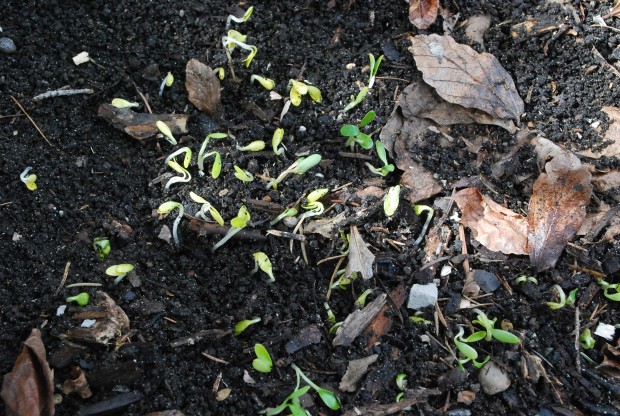 I am shocked and pleased to see that I have hellebore seedlings sprouting. I spent a few moments taking this in, before I covered them up. I am not sure how long it will be, before I expose them to the light of the new season. The pruning and the cleaning-all in good time. A slow spring-this is what we have now.
I am shocked and pleased to see that I have hellebore seedlings sprouting. I spent a few moments taking this in, before I covered them up. I am not sure how long it will be, before I expose them to the light of the new season. The pruning and the cleaning-all in good time. A slow spring-this is what we have now.
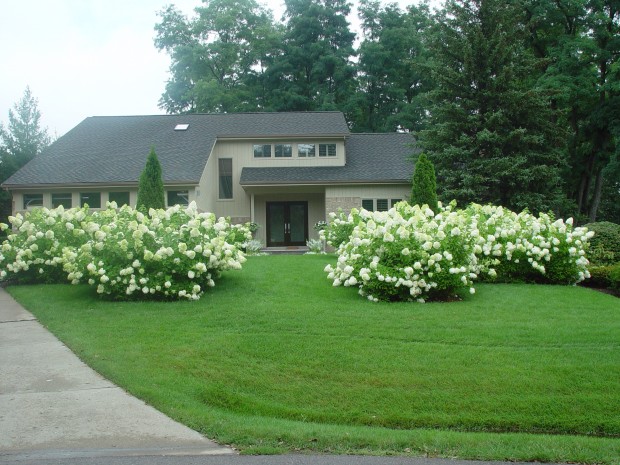
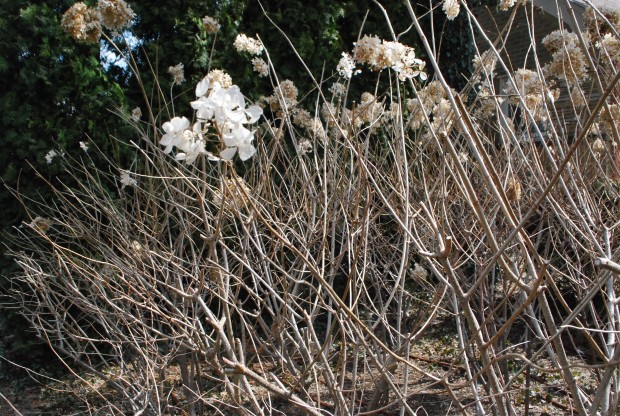
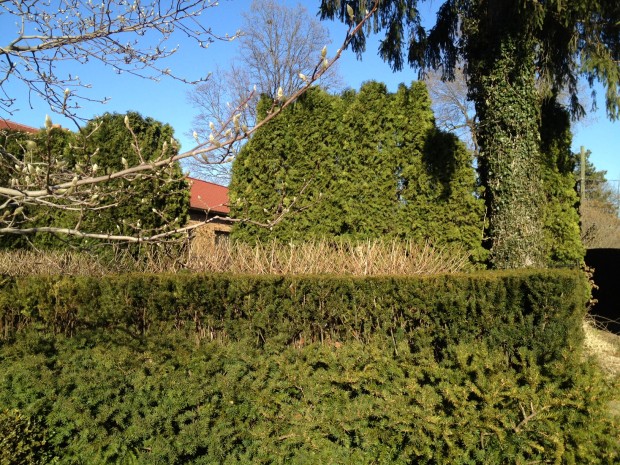

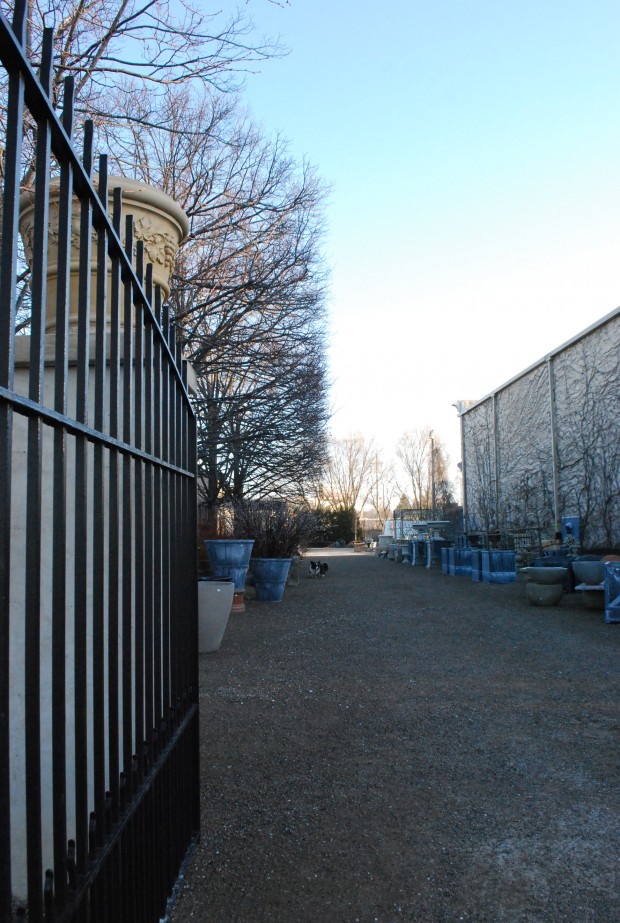
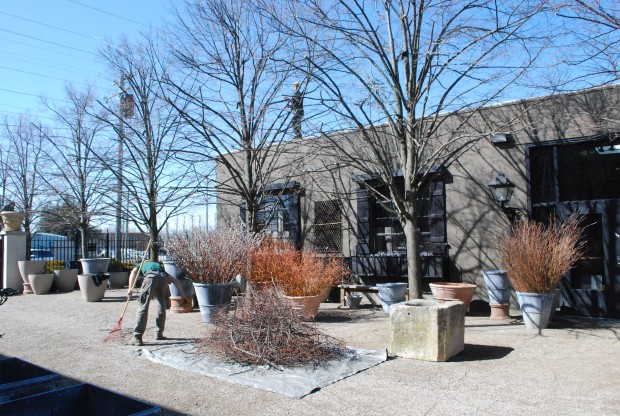
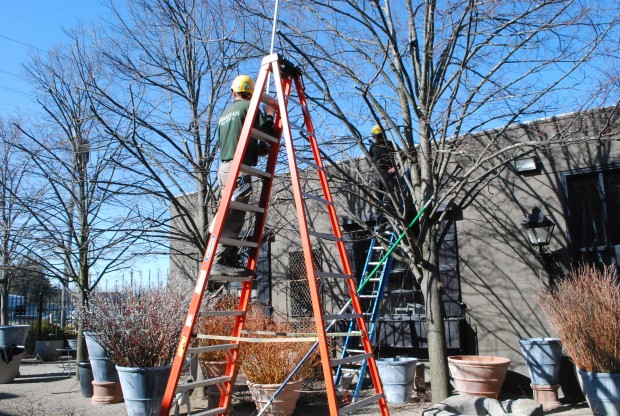
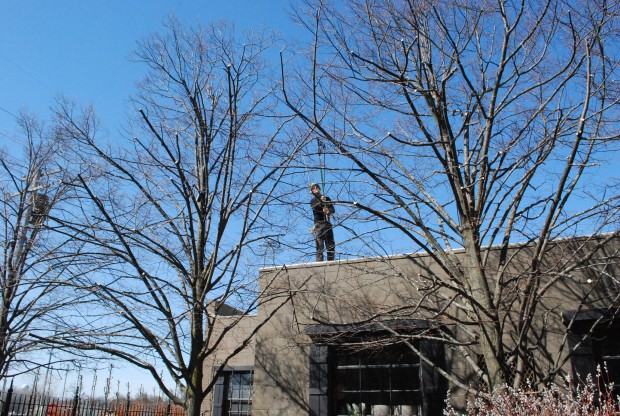

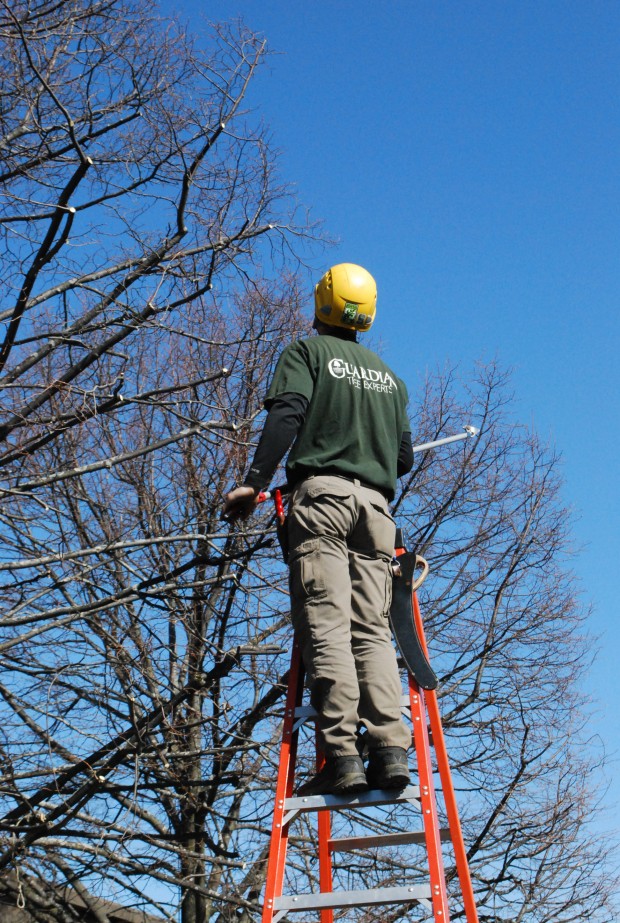
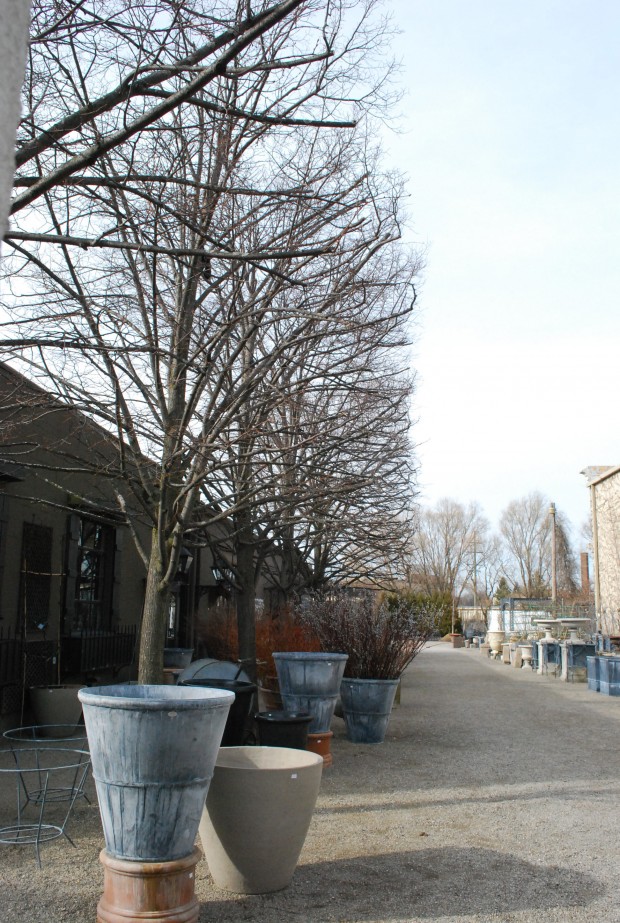
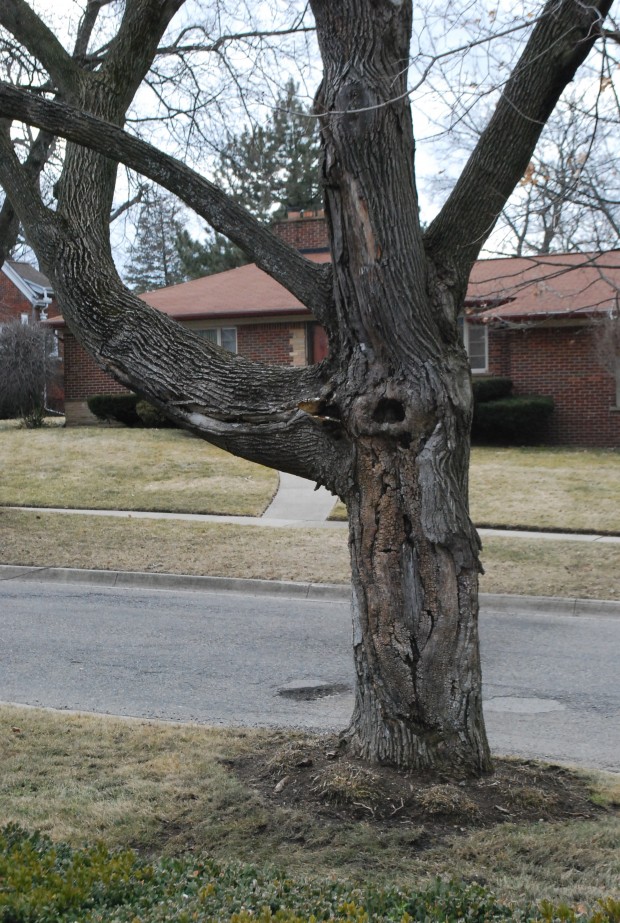
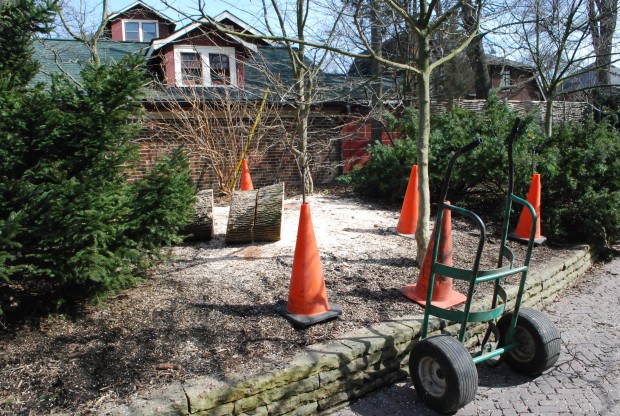
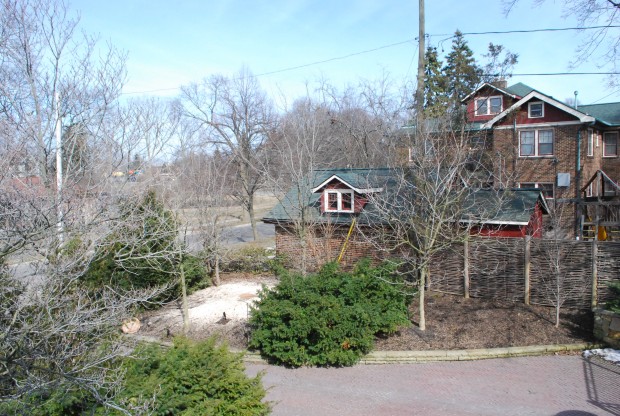
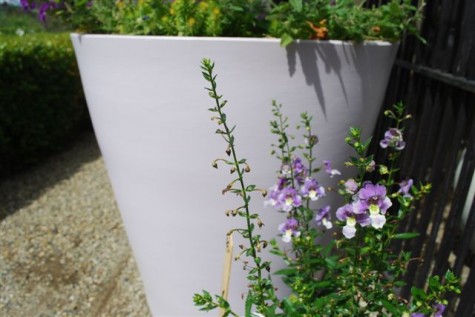
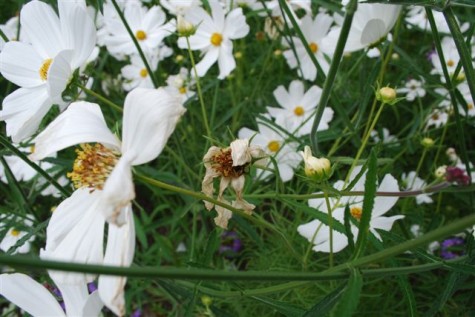
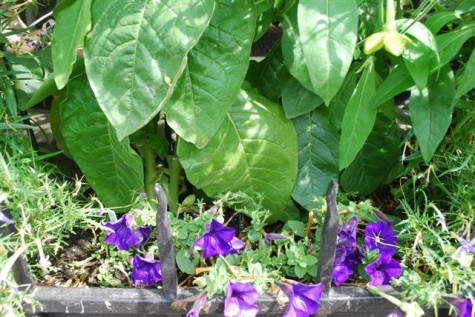 Plants grow in, and the room can get crowded. If the giant leaves of this nicotiana are allowed to shade the petunia, said petunia will pout, and finally give up. Removing leaves, or branches so everyone has a sunny spot, is good group management. A pot or window box is no place for a bully running amok. No one will like the result- least of all, you.
Plants grow in, and the room can get crowded. If the giant leaves of this nicotiana are allowed to shade the petunia, said petunia will pout, and finally give up. Removing leaves, or branches so everyone has a sunny spot, is good group management. A pot or window box is no place for a bully running amok. No one will like the result- least of all, you.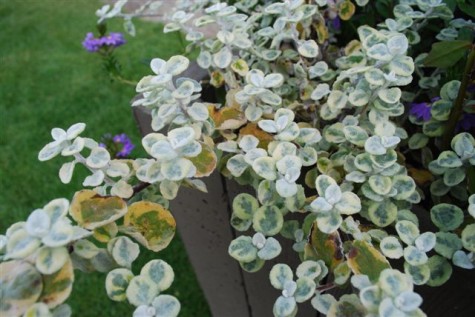 Try not to overwater. Put your finger down into the dirt. If the dirt sticks to you, there is probably enough moisture. Rotting leaves are unsightly. Worse yet, an environment that is too wet is an invitation to every fungus floating by, looking for a good home. Licorice likes dry conditions. Should you have been so bold to plant it next to an annual that loves water and more water, you’ve engineered a situation where individual plants in a community pot have to be watered on different schedules. This is not tough, just time-consuming.
Try not to overwater. Put your finger down into the dirt. If the dirt sticks to you, there is probably enough moisture. Rotting leaves are unsightly. Worse yet, an environment that is too wet is an invitation to every fungus floating by, looking for a good home. Licorice likes dry conditions. Should you have been so bold to plant it next to an annual that loves water and more water, you’ve engineered a situation where individual plants in a community pot have to be watered on different schedules. This is not tough, just time-consuming. Annuals need pruning, just like shrubs and trees. Pruning the flowers from your coleus plants result in densely growing coleus. Pruning plants at different heights gives everyone breathing room. Once a group of plants are put together in one pot, or one area, they take on a collective life. Sun, water and space have to be shared. And whatever the individual plants, you want an overall shape that looks great.
Annuals need pruning, just like shrubs and trees. Pruning the flowers from your coleus plants result in densely growing coleus. Pruning plants at different heights gives everyone breathing room. Once a group of plants are put together in one pot, or one area, they take on a collective life. Sun, water and space have to be shared. And whatever the individual plants, you want an overall shape that looks great. 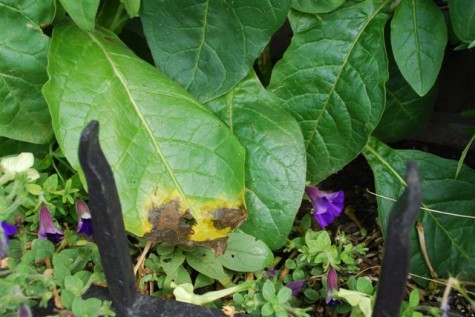
 My beloved boxwood hedge was attacked this spring by a fungus called Volutella-I was beside myself over the damage. I had to get an expert to identify it for me; I have never seen this on boxwood before. We cleaned out, and raked up every dead leaf, and pruned out every infected branch with shears that were disinfected after each cut. Next spring I will spray for it. Imagine being a greenhouse grower-where plant illnesses and insects can threaten a livlihood. Most growers that I know practice close inspection of their plants, so they catch problems early. They also feed their plants; strong plants resist trouble. Once every seven to ten days I make sure my pots are thoroughly watered, then I liquid- feed them with a water soluble fertilizer with a big middle number (15-30-15) to encourage good flower production. This acts like a shot of vitamin B-12. Then I hold off watering as long as I can, so the plants take up the nutrients, before they get flushed out by the next round of watering.
My beloved boxwood hedge was attacked this spring by a fungus called Volutella-I was beside myself over the damage. I had to get an expert to identify it for me; I have never seen this on boxwood before. We cleaned out, and raked up every dead leaf, and pruned out every infected branch with shears that were disinfected after each cut. Next spring I will spray for it. Imagine being a greenhouse grower-where plant illnesses and insects can threaten a livlihood. Most growers that I know practice close inspection of their plants, so they catch problems early. They also feed their plants; strong plants resist trouble. Once every seven to ten days I make sure my pots are thoroughly watered, then I liquid- feed them with a water soluble fertilizer with a big middle number (15-30-15) to encourage good flower production. This acts like a shot of vitamin B-12. Then I hold off watering as long as I can, so the plants take up the nutrients, before they get flushed out by the next round of watering.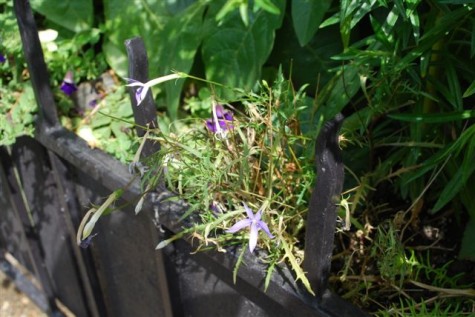
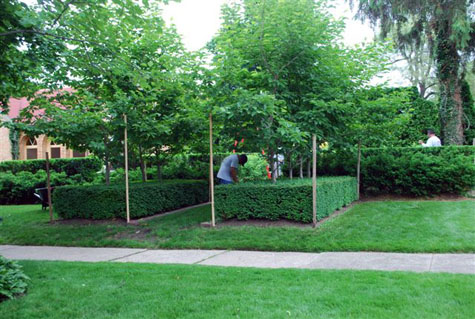 The ability to prune with true precision is as much about a gift, as it is about the science. The big science concept has to do with being able to establish a line level with the horizon, or perfectly horizontal-and its complementary-those lines exactly perpendicular to the horizon-or vertical. Mindy’s crew sets lots of vertical markers-the stakes in this pictures. They use a level to set those stakes exactly vertical.
The ability to prune with true precision is as much about a gift, as it is about the science. The big science concept has to do with being able to establish a line level with the horizon, or perfectly horizontal-and its complementary-those lines exactly perpendicular to the horizon-or vertical. Mindy’s crew sets lots of vertical markers-the stakes in this pictures. They use a level to set those stakes exactly vertical.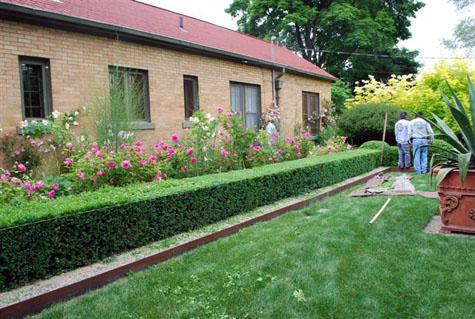 The horizontal plane is determined with a set of lines, or strings. There will be strings everywhere, side to side. But there is plenty of gift involved here too. I perfectly understand the math, but I cannot do this how they do it. Every cut is made with giant, long handled shears-by hand. The clip clip takes 7 people, an entire day; its a slow but sure process that I enjoy watching. Even the sound of the clip clip takes my blood pressure down at least 10 points.
The horizontal plane is determined with a set of lines, or strings. There will be strings everywhere, side to side. But there is plenty of gift involved here too. I perfectly understand the math, but I cannot do this how they do it. Every cut is made with giant, long handled shears-by hand. The clip clip takes 7 people, an entire day; its a slow but sure process that I enjoy watching. Even the sound of the clip clip takes my blood pressure down at least 10 points.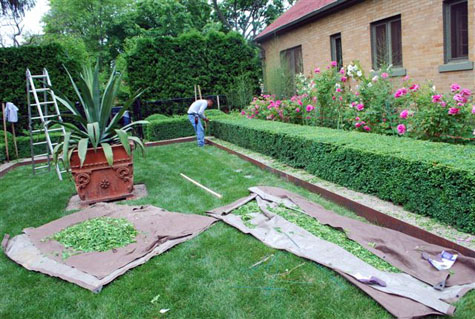 Shape, mass, and volume are very important design elements in landscape. This landscape is entirely geared to the shape, and level of the lawn plane. Every other element has been established, based on that plane. The importance of the lawn plane is accentuated by the wide, overscaled steel edger strip. Where beds and lawn are on the same plane, the edger is invisible; its function is to keep grass out of the planting beds. In this case, the edging is a design element, clearly indicating a change of level. This very geometric change of level provides lots of interest in a very small space. The boxwood pruned into long precise rectangles is a great foil to the sprawling shapes of the roses and perennials.
Shape, mass, and volume are very important design elements in landscape. This landscape is entirely geared to the shape, and level of the lawn plane. Every other element has been established, based on that plane. The importance of the lawn plane is accentuated by the wide, overscaled steel edger strip. Where beds and lawn are on the same plane, the edger is invisible; its function is to keep grass out of the planting beds. In this case, the edging is a design element, clearly indicating a change of level. This very geometric change of level provides lots of interest in a very small space. The boxwood pruned into long precise rectangles is a great foil to the sprawling shapes of the roses and perennials.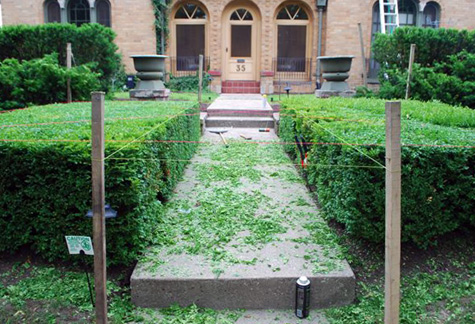 Pruning level with the horizon requires attention to a form that may not exist in the space. The land into which this landscape is planted falls from north to south, and it falls from east to west. To give you an idea of how much drop there is from the south to the north, I measured the height of my Hicks yews. On the southern most end, they are four feet tall, give or take. At the east end of the north side, they are nine feet tall; this is a lot of drop. It was many years, growing those north end yews tall enough to prune. This boxwood is pruned level with the horizon. Pruning with the lay of the land produces an entirely different effect. Level with the horizon gives a landscape a formal and serene aura. As in, on even keel, or level-headed. As my work life is as I have described a big fluid situation, I like the even keel feeling when I am in my garden. This is a choice any gardener makes when designing. What do you want from your space?
Pruning level with the horizon requires attention to a form that may not exist in the space. The land into which this landscape is planted falls from north to south, and it falls from east to west. To give you an idea of how much drop there is from the south to the north, I measured the height of my Hicks yews. On the southern most end, they are four feet tall, give or take. At the east end of the north side, they are nine feet tall; this is a lot of drop. It was many years, growing those north end yews tall enough to prune. This boxwood is pruned level with the horizon. Pruning with the lay of the land produces an entirely different effect. Level with the horizon gives a landscape a formal and serene aura. As in, on even keel, or level-headed. As my work life is as I have described a big fluid situation, I like the even keel feeling when I am in my garden. This is a choice any gardener makes when designing. What do you want from your space?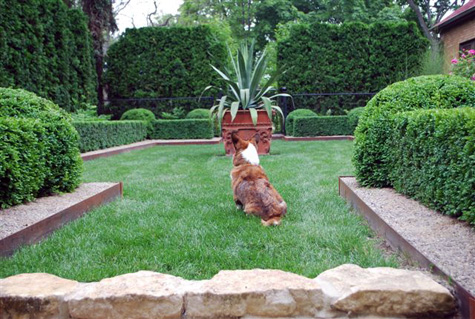 This is my idea of a good place to be.
This is my idea of a good place to be.